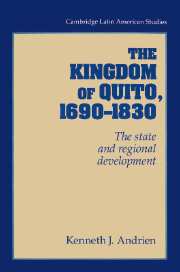Book contents
- Frontmatter
- Contents
- Acknowledgments
- Introduction
- PART I THE STATE AND SOCIOECONOMIC DEVELOPMENT
- 1 The late seventeenth-century crises
- 2 The people and markets of the kingdom
- 3 The state and manufacturing
- 4 Spanish agriculture and the rural economy
- 5 Amerindians and the market economy
- 6 Commerce and economic patterns
- PART II REFORM AND POLITICAL CONFLICT
- Appendixes
- Glossary
- Bibliography
- Index
3 - The state and manufacturing
from PART I - THE STATE AND SOCIOECONOMIC DEVELOPMENT
Published online by Cambridge University Press: 29 September 2009
- Frontmatter
- Contents
- Acknowledgments
- Introduction
- PART I THE STATE AND SOCIOECONOMIC DEVELOPMENT
- 1 The late seventeenth-century crises
- 2 The people and markets of the kingdom
- 3 The state and manufacturing
- 4 Spanish agriculture and the rural economy
- 5 Amerindians and the market economy
- 6 Commerce and economic patterns
- PART II REFORM AND POLITICAL CONFLICT
- Appendixes
- Glossary
- Bibliography
- Index
Summary
European manufacturing and commercial expansion during the eighteenth century had a profound impact on economic development in the Kingdom of Quito. As new methods of cloth production lowered costs and expanded output, it became possible for European manufacturers to supply textiles in distant American markets. At the same time, the Spanish crown aided this process by liberalizing colonial trade policies, which allowed peninsular merchants to ship increasing amounts of these products to the Indies. The resulting importation of European wares captured regional markets in Pacific trading zones and undermined the competitive position of colonial manufacturing centers such as Quito. The local woolen textile economy suffered from a rigid, archaic organizational structure, primitive technology, and a scarcity of capital, making it impossible for it to compete with these European products. The only Quiteño mills capable of surviving over time were those manufacturing cheap, low-quality woolens for the northern markets in New Granada. As a result, the obraje economy entered a prolonged decline during the eighteenth century.
As the obraje sector decayed, a prosperous cotton and woolen textile industry emerged in the south sierra, principally in the corregimiento (and later gobernación) of Cuenca. This industry was concentrated in the Amerindian villages of the southern highlands, where merchants (mostly from Lima) organized a cottage or putting-out system of manufacturing. The merchants usually supplied the raw cotton and wool, while the villagers – usually women – used traditional Andean methods of spinning and weaving to produce coarse cotton and woolen cloth. The merchantentrepreneurs then used their commercial connections to market these cheap, low-quality textiles in the cities and mining centers of northern Peru.
- Type
- Chapter
- Information
- The Kingdom of Quito, 1690–1830The State and Regional Development, pp. 55 - 79Publisher: Cambridge University PressPrint publication year: 1995



